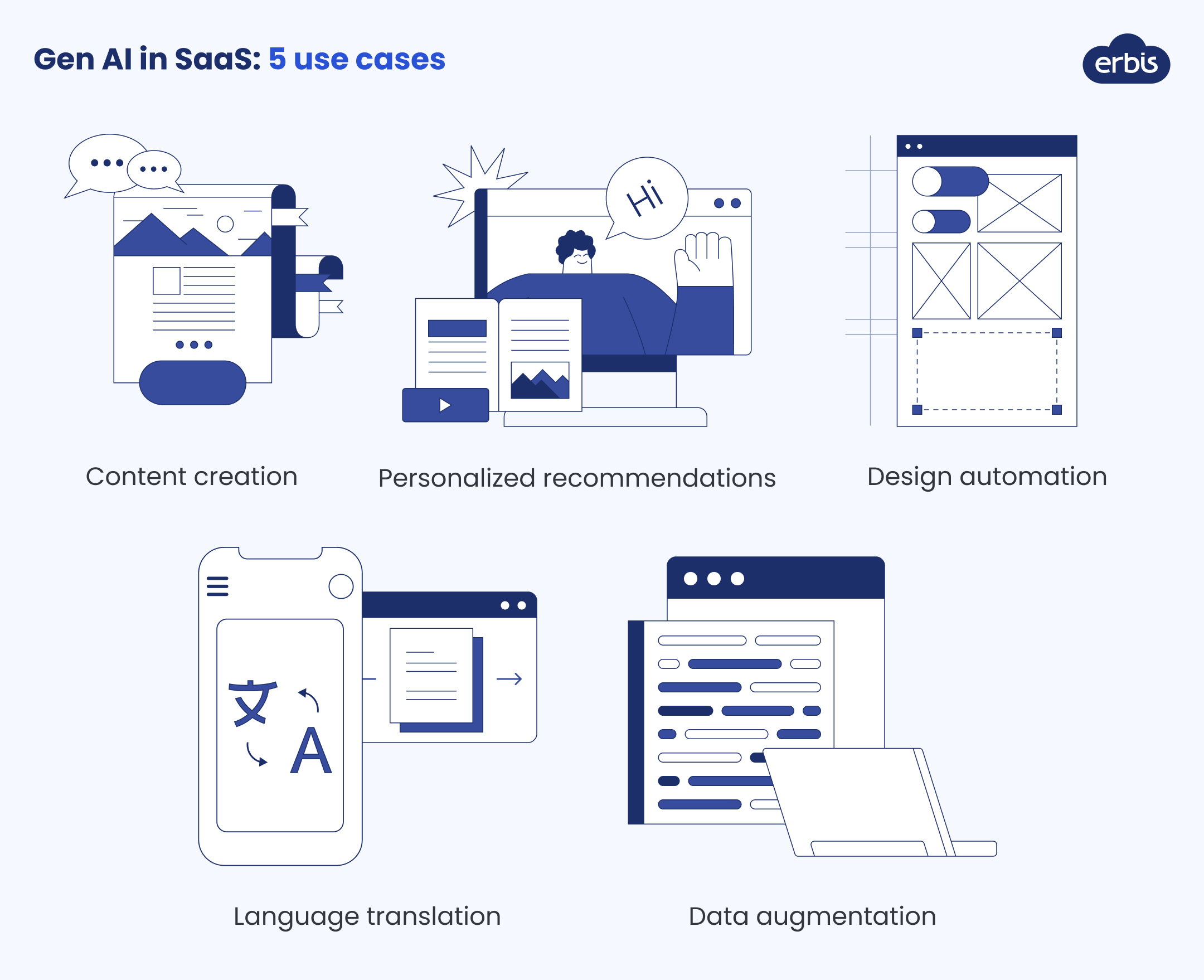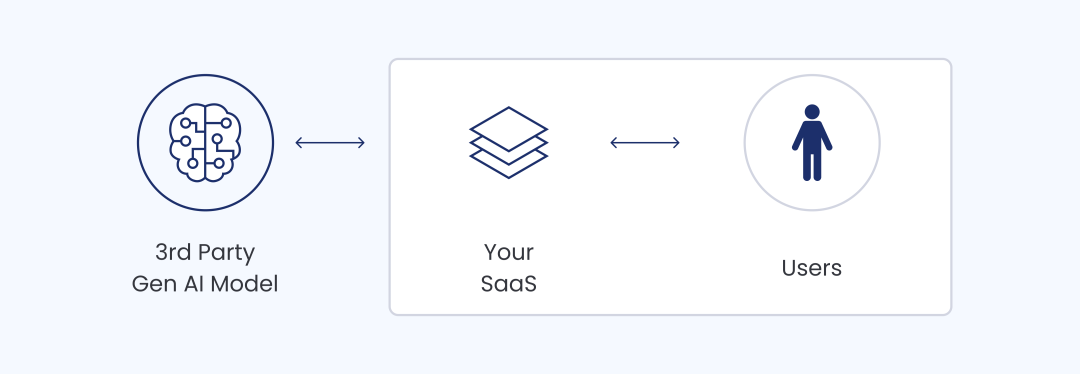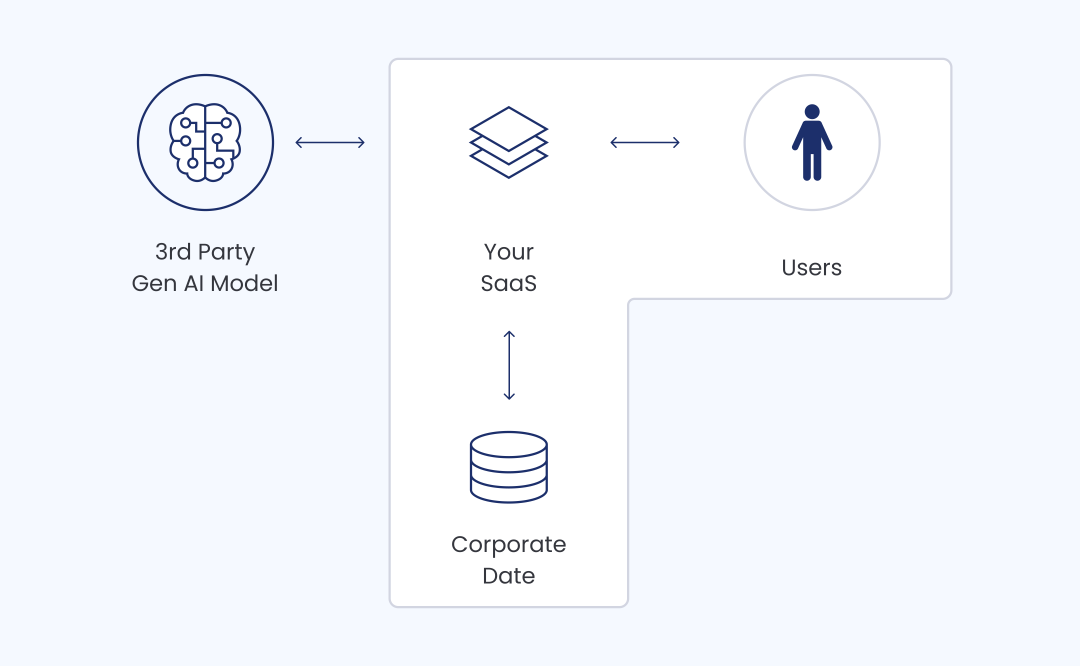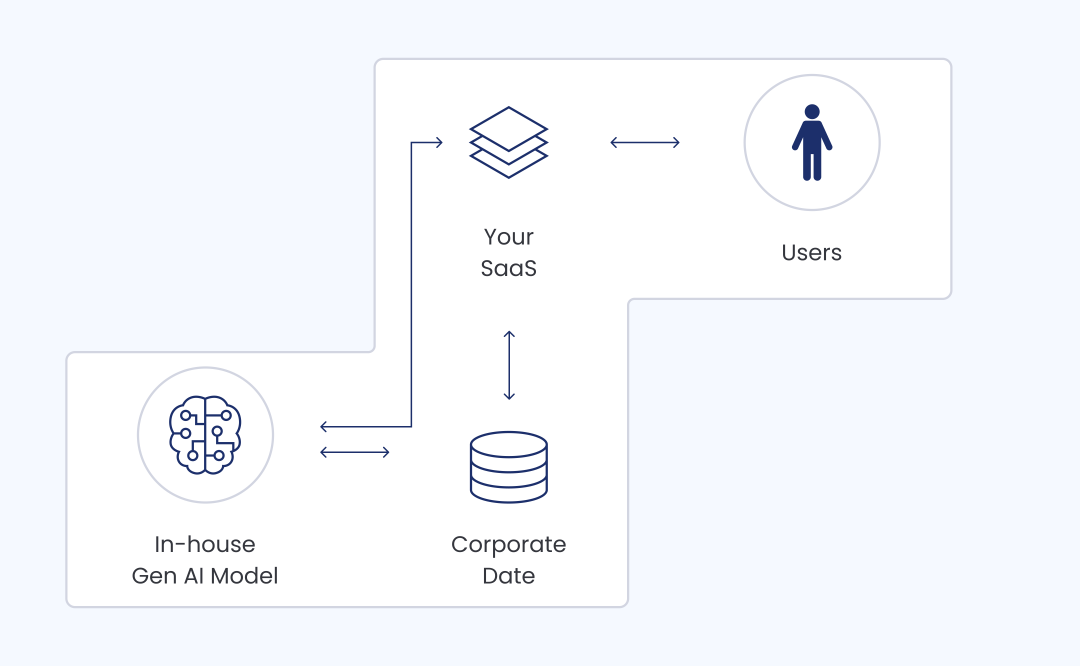Generative AI in SaaS: Use Cases, Integration Ways, Monetization
Generative AI in SaaS is not just a technology trend but a highly effective tool that can make software more functional and appealing to customers. Artificial intelligence can be a game-changer for your SaaS development business, helping you gain a competitive edge and increase market penetration.
There are many ways how you can use AI in SaaS regardless of your industry specifics. There are also diverse ways to incorporate AI in your SaaS platform, monetize it, and make it a valuable part of the artificial intelligence technology landscape.
What is generative AI in SaaS?
Generative AI in SaaS is a technology that creates new content, including text, images, code, music, etc. It often needs clear input data - prompt - based on which it makes new content.
Generative AI in SaaS can greatly enhance the functionality of your software product. You can increasingly see generative AI in SaaS products, even if their primary purpose does not directly involve creating content.
Before starting wit
h generative artificial intelligence SaaS, it is important to clarify the following notions:
Generative AI vs. AI. AI is a broad term that encompasses all types of technology that simulate human intelligence, including generative AI. However, in traditional understanding, AI uses predefined algorithms to process data and make decisions. This is unlike generative AI, which uses prompts to produce new, not previously existing content.
Generative AI vs. predictive AI. The first one is more about creativity; the second one is about analytics. Predictive AI can foresee a situation based on historical facts and patterns. On the flip side, generative AI cannot make reliable assumptions for informative decision-making.
Generative AI vs. conversational AI. These have different objectives and use cases. Generative AI creates original content and performs creative tasks. Conversational AI understands, interprets, and responds to user input in real-time conversations.
How to use generative AI in SaaS: 5 ideas
Generative AI is a valuable tool to make your SaaS more functionally rich and expand your customer base. Many SaaS companies are already implementing AI into their products, so why wouldn't you keep up with the trend?
Here are some ideas on how you can use generative AI in your SaaS:
Content creation
AI can generate blog posts, product descriptions, marketing copies, and more. You can incorporate generative AI in content management systems, email management platforms, e-commerce platforms, and other SaaS where users create some kind of content.
Example: WordPress and HubSpot empower their users with the ability to generate AI content.
Personalized recommendations
AI can keep your SaaS users hooked with personalized recommendations tailored to their preferences. Streaming services, learning management systems, and e-commerce solutions are those that benefit most from AI-generated recommendations.
Example: Amazon and Netflix provide personalized AI recommendations to enhance the user experience.
Design automation
AI-driven design tools simplify graphic design tasks. AI can create stunning graphics, illustrations, and website layouts, enabling your SaaS users to design like pros. Visual design tools powered by AI have a competitive advantage over those that don't.
Example: Canva or Adobe Creative Cloud offer AI-powered design automation features.
Language translation
Generative AI professionally translates texts and speech. Communication and collaboration SaaS platforms can benefit from these AI features, enabling better connections between international colleagues or friends.
Example: Slack and Zoom leverage AI for real-time language translation, enhancing user collaboration and communication.
Data augmentation
AI can create data samples based on existing data. This helps expand the original dataset and improve the performance of machine learning models trained on these data. This use case is particularly beneficial for business intelligence SaaS.
Example: Tableau and AnswerRocket leverage AI for data augmentation, empowering users with deeper insights.

How to incorporate generative AI into SaaS
There are three ways to integrate generative AI into your SaaS. Each method has its advantages and considerations. You should choose one that best meets your needs.
Integrate third-party AI service with no access to your data
This means that you integrate a ready-made generative AI service into your SaaS via API. The gen AI does not have access to your data lakes, data warehouses, wiki, or documents. Even though it understands what your SaaS is about, it cannot generate highly tailored information/content.
Advantage: You can quickly access AI capabilities
Limitation: You have small room for customization
Use cases: The ideal scenarios involve providing information for business-related queries such as industry regulations, supply chain management, risk assessment, and legal consulting. Third-party AI services are also useful for sentiment analysis and do not require access to corporate data in this case.
AI technologies: Azure OpenAI Service (GPTe4, gpte3.5eturbo), Google Cloud (PaLM 2), Amazon Bedrock (Titan, Claude 2, etc.), Nvidia NeMo.
Cost: The monthly expense for utilizing a third-party generative AI in SaaS depends on the volume of data processed and generated. For example, using a sentiment analysis tool to process 100,000 customer reviews per month could cost between $500 and $1,500 monthly, depending on the selected AI service provider and the complexity of the analysis required.

Let AI systems access your SaaS data
If you want to use existing AI systems (large language models - LLMs) with your own data, you can do so without training the system yourself. Instead, you can use the method called embeddings. This method allows the integration of a generative AI system with your SaaS data.
Thus, you can take advantage of the specific knowledge your organization has gathered over time. In simple terms, the AI will generate specific content based on your data rather than universal data accessible via the Internet.
Advantage: Stronger focus on the specifics of your SaaS in the AI-generated content
Limitation: Additional effort is needed from the development team, such as setting logic for data extraction and adjusting data infrastructure for storing the embeddings.
Use cases: This pattern is most suitable for scenarios that depend on corporate data and knowledge. They include customer support, marketing content creation, reporting, AI job assistants, etc.
AI technologies: Azure OpenAI, Amazon Bedrock, Google Cloud Embedding API, Cohere, and Nvidia NeMo.
Cost: The cost is based on usage, such as the number of tokens processed or the volume of data indexed. It can range from a few hundred to several thousand dollars per month, depending on the scale of usage and the chosen service. For example, if the token is a word in a document and you need to index 1 million 30-page documents, that would cost you about $1600 per month.

Train AI model on your data
If you want your SaaS to provide highly specific and business-related content, you can achieve this by training a machine learning (ML) model on your data. This approach to integrating AI into SaaS is the most time-consuming and costly. However, you can reduce the costs by using a pre-trained foundation model and then fine-tuning it on your data.
Advantage: You gain the highest level of customization and control over produced content.
Limitation: You need to invest time and money to train a machine-learning model for your SaaS.
Use cases: This approach of using generative AI in SaaS is the most suitable for industries like healthcare, finance, or legal. Such domains have strict requirements for content and cannot tolerate any inaccuracies in it. For instance, a healthcare SaaS platform might train a custom AI model on patient data to provide personalized treatment recommendations.
AI technologies: Google Vertex AI, Amazon SageMaker, Microsoft Azure Machine Learning, HuggingFace Hub, and Nvidia NeMo.
Cost: The cost is calculated based on the amount of data processed, the compute resources utilized (CPU, GPU hours), and any additional services required.
For example, suppose you're using a cloud-based service like Google Cloud Vertex AI or Amazon SageMaker. In that case, the cost may be determined by factors such as the number of training instances used, the duration of training, and any additional services utilized (such as data storage or model deployment).
Similarly, suppose you're using open-source tools for fine-tuning foundational models. In that case, the cost may be primarily associated with the compute resources required to train the model, such as GPU hours or storage costs.
Note that the price range in this case may vary from thousands to millions of dollars.

How to monetize the usage of gen AI in your SaaS
SaaS platforms that incorporate AI use various approaches to earn on their AI-driven features. Monetization models for such SaaS platforms include:
Subscription-based pricing. SaaS platforms offer AI-powered features as part of premium packages. Users pay a recurring fee to access advanced functionality that includes AI-driven insights, recommendations, or automation features.
Example: HubSpot offers tiered subscription plans with AI-powered features like predictive lead scoring and personalized content recommendations.
Usage-based pricing. SaaS charge users based on the volume or frequency of AI-driven interactions. This model can be suitable for SaaS platforms that provide AI-driven analytics, data processing, or content generation services.
Example: Twilio provides natural language understanding (NLU) and sentiment analysis for text messages and voice interactions. It charges users based on the volume of messages or calls processed.
Feature-based upgrades. SaaS provide AI-driven features as optional add-ons to existing subscription plans. Users can use AI functionality by paying an extra fee on top of their standard subscription.
Example: Mailchimp offers AI-driven predictive insights and audience segmentation as premium add-ons to its standard email marketing plans.
Pay-per-use. SaaS charge users based on the specific AI-powered services they utilize within the platform. This model allows users to pay only for the AI-driven features they actually use, making it suitable for platforms with diverse AI functionalities.
Example: Google Cloud Natural Language API allows developers to access NLP capabilities such as entity recognition and sentiment analysis on a pay-per-use basis. The pricing is based on the number of API calls made.
Enterprise licensing. SaaS offer customized licensing agreements for businesses that require tailored AI solutions. This model is suitable for enterprise clients seeking comprehensive AI capabilities tailored to their needs.
Example: Salesforce Einstein provides AI-powered CRM capabilities for sales, marketing, and customer service. It offers enterprise licensing agreements for businesses that need to integrate custom AI solutions into their Salesforce workflows.
Getting started with generative AI in your SaaS
The quality of AI-generated content may be debatable, but its ability to speed up work is undeniable. Therefore, not using AI these days puts you at a disadvantage compared to your competitors.
SaaS providers see AI as a way to improve user experience. AI helps SaaS customers work faster and more productively, and they are willing to pay for it.
If you haven't integrated AI into your SaaS yet, now is the perfect time to do so. Start by defining your goals and outcomes, and then choose a way to integrate generative AI into your SaaS. Finally, hire a team to successfully implement AI integration.
If you've read this far, you probably suspect we're going to invite you to contact us because we have something to offer you when it comes to AI development and integration.
